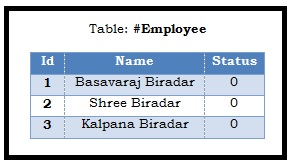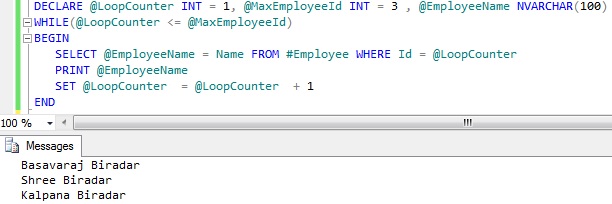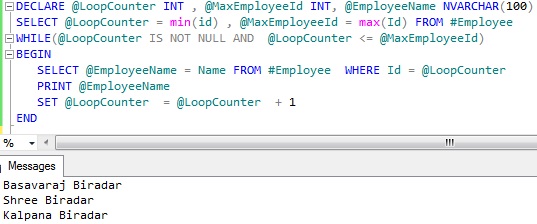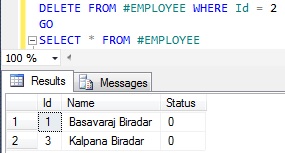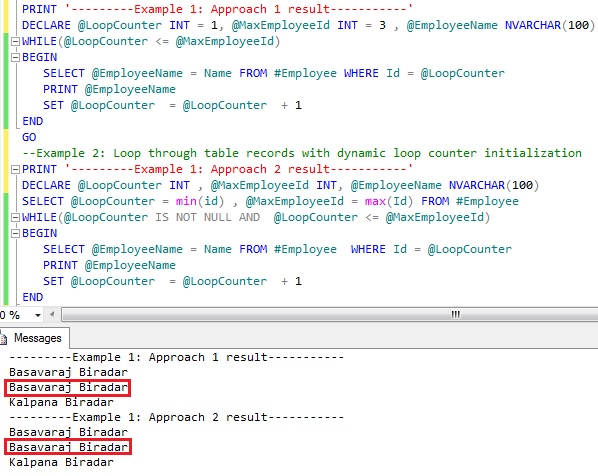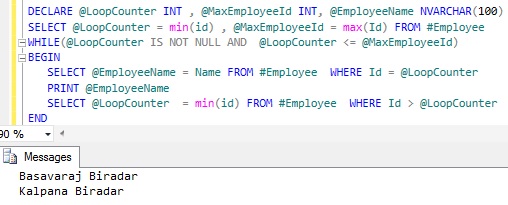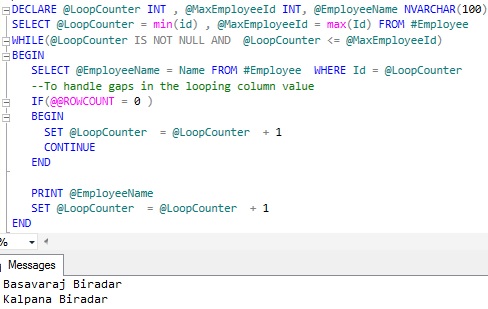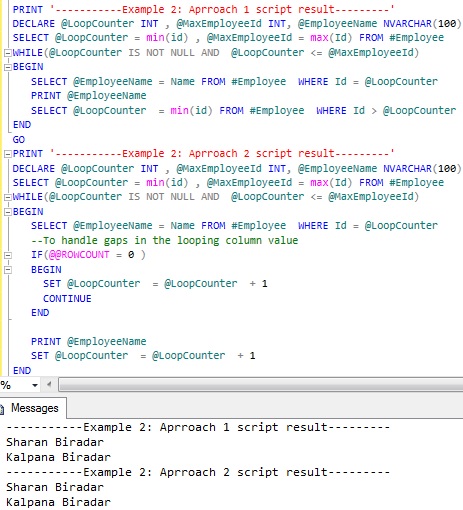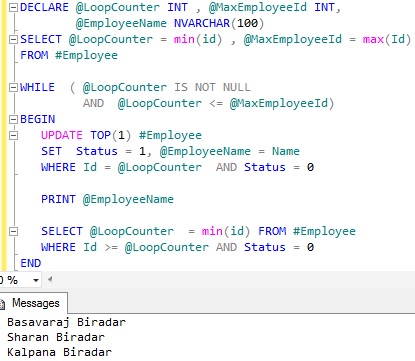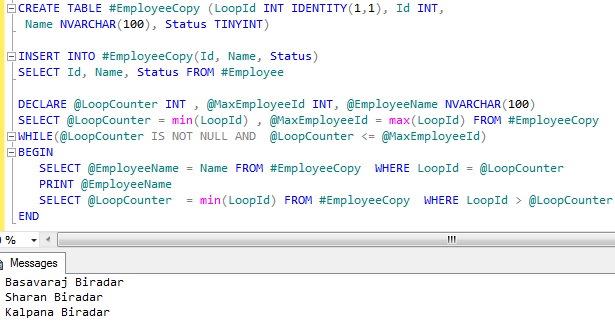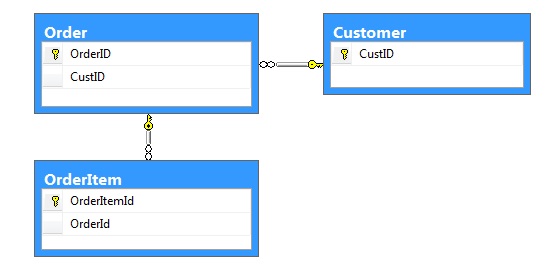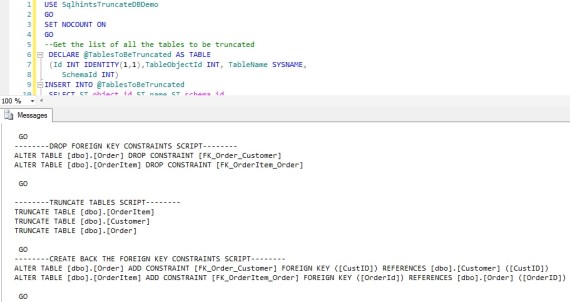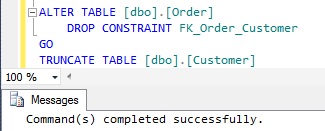This article lists out extensive list of example scripts for looping through table records one row at a time. This article covers the examples for the following scenario’s for looping through table rows
- Looping column having no gaps/duplicate values
- Looping column having gaps
- Looping column having duplicates
[ALSO READ] WHILE loop in Sql Server
To understand the looping of the table records in the above listed scenarios, let us first create a temporary table #Employee as shown in the below image with sample data using the following script.
USE TEMPDB GO CREATE TABLE #Employee (Id INT, Name NVARCHAR(100), Status TINYINT) GO INSERT INTO #Employee ( Id, Name, Status) Values (1, 'Basavaraj Biradar', 0), (2, 'Shree Biradar', 0), (3, 'Kalpana Biradar', 0) GO
The below examples illustrates how we can loop through table records in various ways. And also highlights the problem if any. Please go through all the examples before deciding on using one particular approach.
Example 1: Looping column having no gaps/duplicate values
Approach 1: Looping through table records with static loop counter initialization
DECLARE @LoopCounter INT = 1, @MaxEmployeeId INT = 3 ,
@EmployeeName NVARCHAR(100)
WHILE(@LoopCounter <= @MaxEmployeeId)
BEGIN
SELECT @EmployeeName = Name
FROM #Employee WHERE Id = @LoopCounter
PRINT @EmployeeName
SET @LoopCounter = @LoopCounter + 1
END
In this example the loop running variable @LoopCounter and the maximum loop counter variable @MaxEmployeeId values are initialized with a static value.
Note: This approach of looping through table rows doesn’t work if the looping column (i.e. in this case Id column of the #Employee table) values have gaps or if it has duplicate values
Approach 2: Looping through table records with dynamic loop counter initialization
DECLARE @LoopCounter INT , @MaxEmployeeId INT,
@EmployeeName NVARCHAR(100)
SELECT @LoopCounter = min(id) , @MaxEmployeeId = max(Id)
FROM #Employee
WHILE(@LoopCounter IS NOT NULL
AND @LoopCounter <= @MaxEmployeeId)
BEGIN
SELECT @EmployeeName = Name
FROM #Employee WHERE Id = @LoopCounter
PRINT @EmployeeName
SET @LoopCounter = @LoopCounter + 1
END
In this example the loop running variable @LoopCounter and the maximum loop counter variable @MaxEmployeeId values are initialized dynamically.
Note: This approach of looping through table rows doesn’t work if the looping column (i.e. in this case Id column of the #Employee table) values have gaps or if it has duplicate values
Example 2: Looping through table records where looping column has gaps
Issue with example 1’s approach 1 and 2: These example approaches are assuming that looping column values doesn’t have any gap in it. Let us see what is the output of the example 1’s approach 1 and 2 if we have gaps in the looping column value.
To create a gap, delete employee record from the #Employee table with id = 2 by the following script:
DELETE FROM #EMPLOYEE WHERE Id = 2
Now let us run the example 1’s approach 1 and 2 script on #Employee table which is having gap in the Id column value (i.e. record with id column value 2 is missing).
From the above result it is clear that the example 1’s approach 1 and 2 script will not work in the scenarios where we have gap in the looping tables column values.
This problem can solved in multiple ways, below are two such example approaches. I would prefer the first approach.
Approach 1: Looping through table records where looping column has gaps in the value
DECLARE @LoopCounter INT , @MaxEmployeeId INT,
@EmployeeName NVARCHAR(100)
SELECT @LoopCounter = min(id) , @MaxEmployeeId = max(Id)
FROM #Employee
WHILE ( @LoopCounter IS NOT NULL
AND @LoopCounter <= @MaxEmployeeId)
BEGIN
SELECT @EmployeeName = Name FROM #Employee
WHERE Id = @LoopCounter
PRINT @EmployeeName
SELECT @LoopCounter = min(id) FROM #Employee
WHERE Id > @LoopCounter
END
From the above result it is clear that this script works even when we have gaps in the looping column values.
Note: This approach of looping through table rows doesn’t work if the looping column (i.e. in this case Id column of the #Employee table) has duplicate values
Approach 2: Looping through table records where looping column has gaps in the value
DECLARE @LoopCounter INT , @MaxEmployeeId INT,
@EmployeeName NVARCHAR(100)
SELECT @LoopCounter = min(id) , @MaxEmployeeId = max(Id)
FROM #Employee
WHILE ( @LoopCounter IS NOT NULL
AND @LoopCounter <= @MaxEmployeeId)
BEGIN
SELECT @EmployeeName = Name
FROM #Employee WHERE Id = @LoopCounter
--To handle gaps in the looping column value
IF(@@ROWCOUNT = 0 )
BEGIN
SET @LoopCounter = @LoopCounter + 1
CONTINUE
END
PRINT @EmployeeName
SET @LoopCounter = @LoopCounter + 1
END
From the above result it is clear that this script works even when we have gaps in the looping column values.
Note: This approach of looping through table rows doesn’t work if the looping column (i.e. in this case Id column of the #Employee table) has duplicate values
Example 3: Looping through table records where looping column having duplicates
To create a duplicate record, insert one more employee record to the #Employee table with id = 1 by the following script:
INSERT INTO #Employee ( Id, Name, Status) Values (1, 'Sharan Biradar', 0)
Now let us run the example 2’s approach 1 and 2 script on #Employee table which is having duplicate Id column values (i.e. there are two records with with Id column value as 1)
From the above result it is clear that the example 2’s approach 1 and 2 script will not work in the scenarios where we have duplicates in the looping column. Here only one record of the employee with id =1 is displayed and other record is skipped. This problem can solved in multiple ways, below are two such example approaches.
Approach 1: Looping through table records where looping column has duplicate values
SET NOCOUNT ON
DECLARE @LoopCounter INT , @MaxEmployeeId INT,
@EmployeeName NVARCHAR(100)
SELECT @LoopCounter = min(id) , @MaxEmployeeId = max(Id)
FROM #Employee
WHILE ( @LoopCounter IS NOT NULL
AND @LoopCounter <= @MaxEmployeeId)
BEGIN
UPDATE TOP(1) #Employee
SET Status = 1, @EmployeeName = Name
WHERE Id = @LoopCounter AND Status = 0
PRINT @EmployeeName
SELECT @LoopCounter = min(id) FROM #Employee
WHERE Id >= @LoopCounter AND Status = 0
END
In this approach using the Status column to mark the records which are already processed. And also the update statement is used to update the status and also get the row values and one more thing is in Update using the TOP statement to update only one record at a time.
Approach 2: Looping through table records where looping column has duplicate values by inserting records into another temp table with identity column
--Create another temp table with identity column
CREATE TABLE #EmployeeCopy (LoopId INT IDENTITY(1,1),
Id INT, Name NVARCHAR(100), Status TINYINT)
--Copy data to the table with identity column
INSERT INTO #EmployeeCopy(Id, Name, Status)
SELECT Id, Name, Status FROM #Employee
DECLARE @LoopCounter INT , @MaxEmployeeId INT,
@EmployeeName NVARCHAR(100)
SELECT @LoopCounter = min(LoopId),@MaxEmployeeId = max(LoopId)
FROM #EmployeeCopy
WHILE ( @LoopCounter IS NOT NULL
AND @LoopCounter <= @MaxEmployeeId)
BEGIN
SELECT @EmployeeName = Name
FROM #EmployeeCopy WHERE LoopId = @LoopCounter
PRINT @EmployeeName
SELECT @LoopCounter = min(LoopId)
FROM #EmployeeCopy WHERE LoopId > @LoopCounter
END
In this article I have covered most of the basic scenarios which we across. If you have any other scenario and use different approach, post a comment I will update the article.
